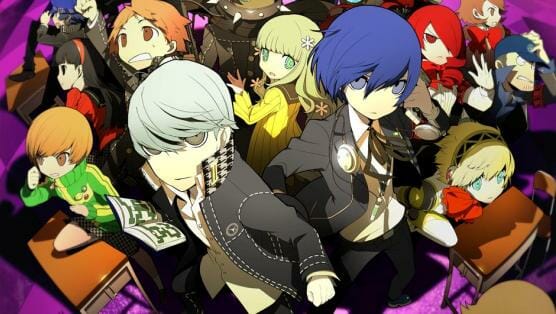Persona Q: A Different Kind of Odyssey

The output of licensed Persona games recently is leading to somewhat outrageous iterations of the RPG franchise, including fighting games and rhythm games. Persona Q: Shadow of the Labyrinth is actually weirder for being a licensed RPG of a RPG series, developed by the Etrian Odyssey team. There are not a lot of non cynical answers to why this game exists, but Persona and Etrian Odyssey are two of my favorite RPG series for opposite reasons—Persona has likable characters and tedious combat, while Etrian Odyssey is story/character minimal but with fantastic dungeon and combat design. So despite the bizarre premise of the game, Persona Q actually ends up solving some of each other’s problems while freeing them both up to experiment with the traditional design conventions of both series.
The premise of Persona Q is kinda indulgent; through plot contrivances, the casts of Persona 3 and Persona 4 are both brought to a school festival where they try to discover the mystery of why they’re trapped there by exploring mysterious dungeons within the classrooms, like an Alice In Wonderland themed dungeon and a Group Date Cafe (which includes a lot of nods to Atlus’s Catherine, including a series of questions that eventually pairs you up with one of the other characters, quite comically). As you progress through the dungeons, there will be opportunities to take “strolls”, short skits between the casts which are hilarious and cute, especially if you’re familiar with Persona 3 and/or 4. Knowing and liking the characters is the requirement for enjoying Persona Q’s story; the plots of either game are dealt with minimally and the real focus is just on bouncing the characters off of each other in silly and amusing ways. In many ways it works better than the social links of the previous games; instead of the protagonist trying to form friendships with arbitrary dialogue options, you’re able to just enjoy the characters hanging out and talking with each other, which is all I’ve ever wanted to do in the first place. You can choose to focus on the Persona 3 or 4 cast, but the other side joins after the first brief dungeon and all of the strolls involve both casts, so the difference is not so huge.
Etrian Odyssey’s game design will feel fairly divergent from most other JRPGs, in part because it was developed as a homage to the original Wizardry, possibly the first RPG that involved creating a party of adventurers and leading them through a dungeon. Wizardry’s core features—a dungeon viewed through first person, a party of characters created by the user, a lack of a mapping feature that forces players to draw maps of the dungeon on graph paper, and the lack of a save function within the dungeon, which makes the game terrifyingly difficul—are all core features of Etrian Odyssey, though the game also introduces a lot of modern design conventions and its own innovations. Maps are drawn on the bottom screen of the DS, characters are built with talent point systems, the difficulty curve is much more fair, and the presence of powerful mid-bosses visible on the map called FOE adds an extremely important layer of puzzle solving to the game’s dungeons.

When I played Bravely Default earlier this year, one of my biggest complaints was how tedious the random encounters and general level design were. Bravely Default is designed to evoke nostalgia as well, but it’s for a different era, straddling the SNES/PSX eras of Final Fantasy, a game that was pushing level design towards depicting fantastic landscapes more than making the dungeons interesting environments to walk around in. Freedom from tile based layouts allowed for players to explore beautiful pre-rendered backgrounds, but it came at the cost of level design.
When the first Etrian Odyssey was localized, Atlus translated some of the director’s development diary—it’s still up there on the old website if you want to read it—and he has some really neat things to say about game development; this was part of the reason I wanted to play the game in the first place. In the director’s words, there’s a difference between knowing an enemy is “very close” and knowing it’s “exactly one space.” Your ability to make plans and calculations is dependent on having that information. This is part of why random encounters are so frustrating. Because they’re random, you have no idea when they’re going to happen, and they will interrupt any exploring of the dungeon you may be attempting. Persona Q has random encounters, but you know when they are going to happen thanks to a meter on your screen that gradually shifts from blue to red with each step you take. You know then that after roughly X steps you’re going to have a fight, and because you cannot save in the dungeon, you can make plans for the next encounter. There are still unknowns and random factors, but the important thing is that you know the unknowns.
Persona Q, as an Etrian Odyssey game, is about resource management as much as it is about strategic turn-based battles. You enter the labyrinth with finite resources, and you have to know when it’s time to turn back so you don’t end up losing everything. Etrian games borrow a bit from survival horror, in a way—the scarcity of resources is part of what drives the tension. You push your way through the labyrinth, mapping it out, finding treasure, getting experience and harvesting monster parts to sell for money, retreat when you’ve had enough, and then try again, a little stronger and wealthier.
